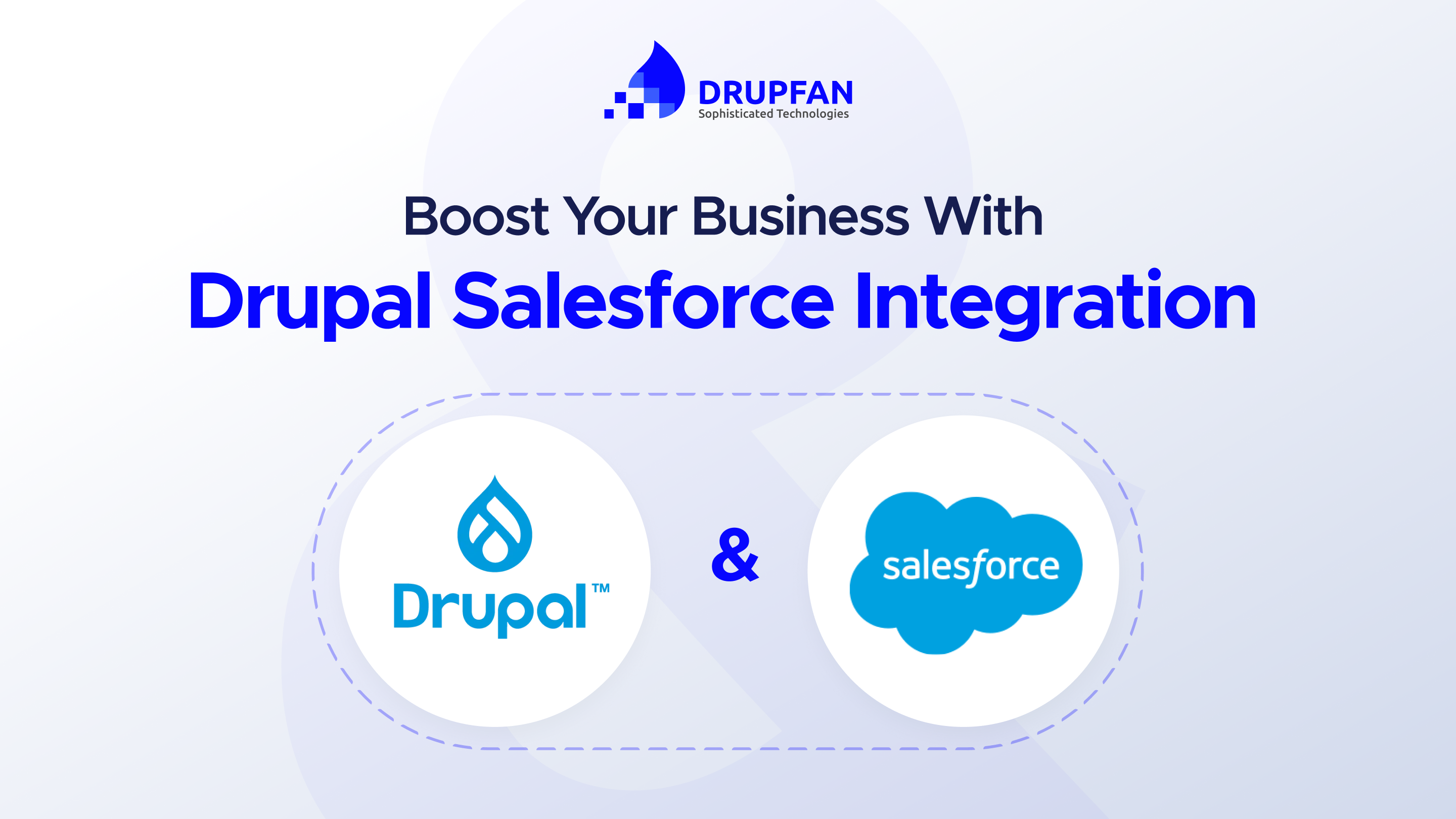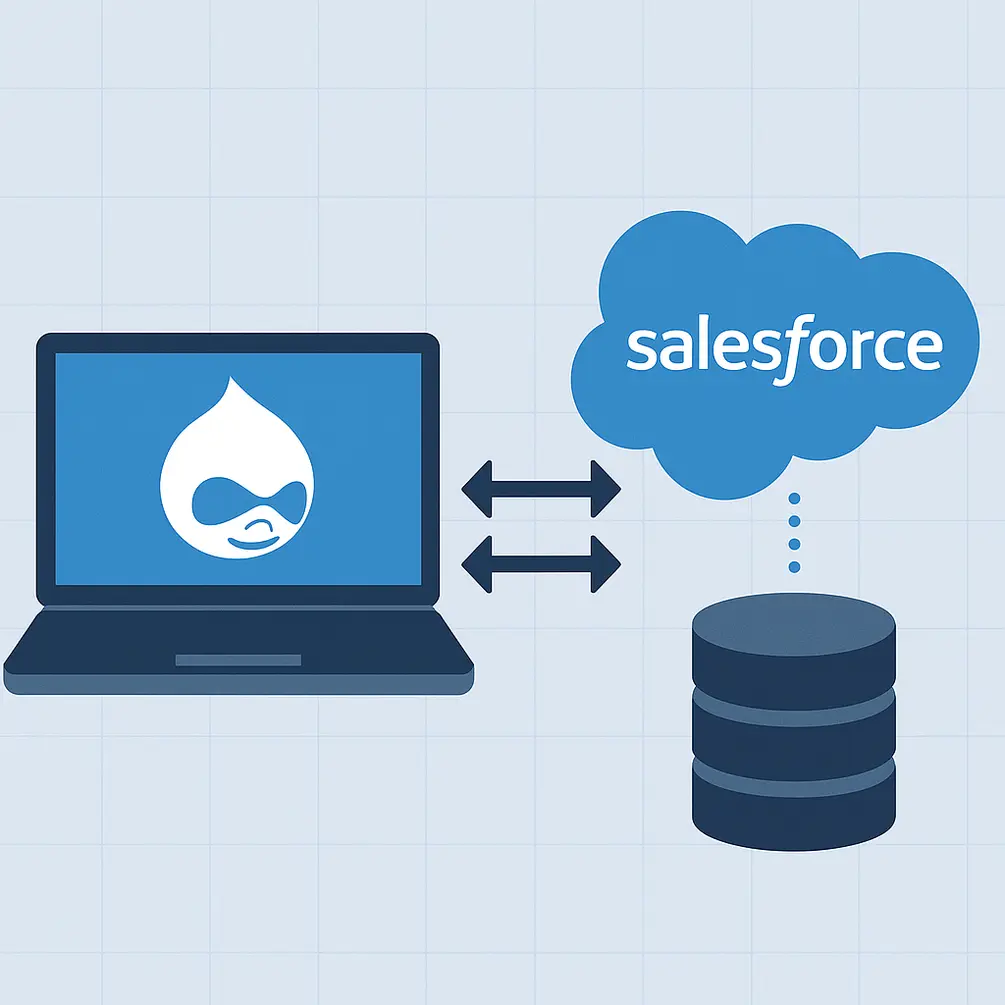What Is Drupal Salesforce Integration?
Drupal Salesforce integration connects a Drupal site with the Salesforce suite so that data flows seamlessly between the two systems. This connection uses modules and APIs to make sure content, customer data, and form submissions reach the Salesforce CRM without the need for manual data entry.

Webform Submissions to Salesforce
When visitors complete a web form on a Drupal website, their information can be synced directly into Salesforce. This eliminates errors caused by manual data entry and makes lead generation immediate and reliable.
Mapping Drupal Entities to Salesforce Objects
The integration enables site administrators to map Drupal entities such as users, nodes, or custom content types to Salesforce objects like Leads, Contacts, or Accounts. This ensures that the right data structure is preserved within CRM.
Automating Lead Capture and Workflows
Drupal and Salesforce integration support workflow automation. For example, a new user registration or content download can automatically trigger updates in Salesforce, helping sales and marketing teams act on fresh customer data.
Key Benefits of Integrating Drupal with Salesforce
Bringing together Drupal and Salesforce creates a powerful foundation for managing customer relationships. Beyond simple data transfer, integration unlocks automation, consistency, and strategic insights. By leveraging the Drupal CMS with your CRM, businesses can streamline workflows and gain more value from customer data.
Centralized Customer Data
Integrating Drupal with a customer relationship management system like Salesforce eliminates duplicate records and reduces manual data entry. All customer information lives in one place, making it easier for teams to manage and trust their data. This tight connection turns your site into an effective management system for marketing and sales.
Real-Time Data Sync
With real-time data sync, new leads or updates on a Drupal site are instantly reflected in Salesforce. This shortens response times and enables sales teams to follow up quickly. Because data flows straight into Salesforce, there is no need for manual exports or imports.
Workflow Automation
Integration connects content and customer interactions on a Drupal website with marketing and sales workflows inside Salesforce. For example, downloading a whitepaper can trigger a campaign in Salesforce Marketing Cloud. Salesforce allows companies to automate lead scoring and campaign activation, making it easier to sync data across departments.
Scalability and Growth
As traffic, content, and user interactions grow, integration scales to handle larger volumes of customer data between the two platforms without requiring ad hoc imports or exports. This is particularly important for enterprises leveraging the Drupal ecosystem for complex sites.
Actionable Insights
When Drupal site behavior is mapped to Salesforce fields, businesses can build dashboards that transform raw customer data into actionable insights. This enables targeted marketing, stronger customer engagement, and better compliance and security through transparent data handling. Integrations can be configured to respect GDPR or CCPA standards, ensuring full regulatory compliance.
How the Salesforce Suite Module Works
The Salesforce Suite module is the main integration tool that allows Drupal websites to communicate with Salesforce CRM. It provides submodules and configuration options that let teams map data, authenticate securely, and manage sync between systems.
Submodules and Mapping
The salesforce module includes submodules such as salesforce_mapping and salesforce_push. These tools let administrators map Drupal fields to Salesforce fields and define how Drupal entities connect with Salesforce objects. Drupal directly integrates entities such as users, nodes, and form submissions straight into Salesforce records.
Secure Authentication
Integration requires a secure connection between the Drupal site and the Salesforce instance. This is achieved through OAuth or JWT authentication. A connected app is created in Salesforce, and a callback URL from the Drupal website is configured to allow the API connection. Using the Salesforce authentication flow ensures compliance and security.
Sync Modes
The module supports one way, two way, and scheduled sync. Teams can choose between real-time data updates, bidirectional synchronization, or periodic batch transfers depending on business needs and Salesforce API limits. Salesforce allows flexibility in how you sync data for different workflows.
Example in Practice
A common scenario is a contact form submission. When a visitor fills in a Drupal webform, the mapped fields are pushed directly to Salesforce CRM as a Lead or Contact. The record can include campaign details, source tracking, and any mapped Drupal entities. This makes it easy to learn how to integrate content and customer interactions from your site straight into Salesforce dashboards.
Advanced Features
The Salesforce Suite module also includes logging, queue management, and permission controls. Developers can extend functionality using hooks or create custom Salesforce integration logic to handle complex workflows. For long-term growth, drupal and salesforce evolve together, offering new integration capabilities with each release of Drupal 8, Drupal 9, and Drupal 10, including Salesforce support for advanced automation.
Easy Steps How to Integrate Drupal with Salesforce
Integrating Drupal with Salesforce is a structured process that combines configuration in Salesforce with setup on the website. Following the right steps ensures secure connections, accurate mapping, and reliable data sync between the two systems.
Create a Salesforce Developer Account and Connected App
Start by creating a Salesforce developer account. Inside Salesforce, configure a connected app that enables your Drupal website to interact with Salesforce CRM. This connected app will generate the client ID, secret, and authentication settings required for the integration.
Install and Enable the Salesforce Suite Module
On your website, install and enable the Salesforce Suite module along with its submodules, such as salesforce_mapping and salesforce_push. These modules provide the tools for mapping Drupal entities and sending data to Salesforce objects.
Configure Authentication
Set up secure authentication using OAuth or JWT. As part of this step, you will set the callback URL in Salesforce to point to your Drupal website, ensuring that both systems can authenticate API calls safely.
Map Drupal Entities to Salesforce Objects
Define how Drupal entities such as users, nodes, or webform submissions map to Salesforce objects like Leads, Contacts, or Accounts. Proper field mapping ensures that customer data is stored in the correct Salesforce fields.
Test Data Sync
Submit a webform or update a content record on your Drupal site to test the sync. Verify that the mapped fields appear correctly in Salesforce and that records are created or updated as expected.
Verify Permissions and Compliance
Review permissions on both sides to confirm that the Drupal site can interact with Salesforce data securely. Ensure compliance with Drupal security standards and regulations such as GDPR and CCPA when handling customer data.
Common Integration Issues and How to Solve Them
Even with proper planning, some issues can arise when integrating Drupal with Salesforce. Recognizing these challenges early and applying the right solutions helps maintain reliable and secure sync.
Misconfigured OAuth Permissions
If OAuth permissions are not configured correctly, authentication may fail. Double-check the connected app settings in Salesforce, including the callback URL and permission scopes.
Errors in Field Mapping
Improper field mapping between Drupal fields and Salesforce fields can cause incomplete or incorrect records. Review mapping rules carefully and test with sample data before going live.
Sync Delays or Conflicts
When handling real-time data, sync delays or duplicate records may appear. Using Salesforce Suite logs and queues helps identify issues and ensures retries are executed automatically.
API Limits from Salesforce Instance
Salesforce imposes daily API limits. Large sync jobs may hit these restrictions. To solve this, consider scheduled syncs, batch processing, or optimizing API usage to stay within allowed limits.
Use Cases and Examples
Drupal Salesforce integration can serve different business goals, from marketing automation to customer data management. The following examples show how integration delivers value across departments.
Lead Generation
Webform submissions on a Drupal website can be pushed directly into Salesforce as Leads. This ensures no potential customer is missed and allows sales teams to respond faster.
Marketing Automation
Integration connects Drupal content interactions with Salesforce marketing and sales workflows. For example, downloading a case study on the site can trigger an automated campaign in Salesforce Marketing Cloud.
Customer Relationship Management
By storing all website interactions in Salesforce CRM, organizations build a complete picture of each customer journey. This helps improve engagement, retention, and personalized communication.
Data Management and Dashboards
Syncing Drupal site data with Salesforce makes it possible to build dashboards that provide actionable insights. Marketing and sales teams can track campaign performance, customer behavior, and return on investment in one central place.
Security, Compliance and Best Practices
Security and compliance are critical when integrating Drupal with Salesforce. Both platforms provide robust security measures, but following best practices ensures customer data remains safe.
Drupal and Salesforce Security
Drupal offers strong security standards, while Salesforce operates in a managed security environment with built-in safeguards for data protection. When combined, the integration benefits from enterprise-level security on both sides.
Use OAuth or JWT Authentication
Always use OAuth or JWT authentication rather than storing credentials directly. This approach reduces risks, provides token-based access, and ensures a secure connection between Drupal and Salesforce.
Compliance with GDPR and CCPA
Customer data must be handled according to privacy regulations such as GDPR and CCPA. Configure your integration to respect consent management and data retention rules.
Regular Updates and Monitoring
Keep the Salesforce Suite module and related dependencies updated. Regularly monitor integration logs and API activity to identify unusual behavior and maintain a secure, stable connection.
Future of Drupal and Salesforce Integration
In 2025 and beyond, Drupal and Salesforce continue to evolve in parallel, offering more sophisticated integration opportunities. The ecosystem around Salesforce Suite is growing, making it easier to connect Drupal entities with Salesforce objects.
Future integrations will include smarter automation, real-time decisioning, and more advanced marketing workflows. Organizations will be able to connect customer journeys across multiple channels, transforming raw data into personalized engagement. For businesses, this means faster response times, more targeted campaigns, and stronger customer loyalty.
Salesforce and Drupal Summary: Why to Choose Drupfan
Integrating Drupal with Salesforce unlocks the full potential of both platforms. It enables data consistency, eliminates manual entry, and connects marketing, sales, and customer service in one seamless flow.
Drupfan specializes in Drupal modules, API integrations, and workflow automation, helping businesses build reliable and scalable Salesforce connections.
Looking to integrate your Drupal site with Salesforce CRM? Contact Drupfan today to create a Salesforce integration that works seamlessly for your business.






